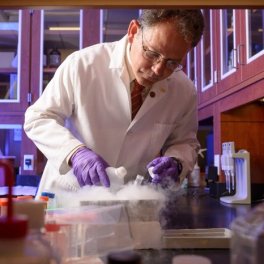About Clay Smith and the Smith Lab
Associate Professor
W. Clay Smith
Dr. Smith received his BS and MS in entomology from the University of Florida in 1986, intrigued by visual function of insects. He continued this interest in graduate school at Yale University, studying retinoid metabolism in the visual process with Prof. Timothy Goldsmith, and earning his PhD in neurobiology in 1990.

The Smith
Laboratory
The principal focus of the Smith laboratory is on the molecular biochemistry and cell biology of the eye, with particular emphasis on the retina. The Smith Lab research has centered on canonical and non-canonical signaling pathways in photoreceptors, particularly focusing on the ancillary cascades signaled by the phototransduction elements. These signaling pathways are relevant to many degenerative and immunological diseases of the eye.

Opportunities
Undergraduate Research
Our laboratory is committed to providing research training experience for motivated undergraduates. Our philosophy is to provide the students with projects that are an integral part of our research program such that they make a significant contribution to our research goals. Many undergraduate projects are included in the publications from our lab. A minimum commitment of two consecutive semesters is required. If interested, please contact Clay Smith (wcsmith@ufl.edu) for more information.

Areas of Interest
Our principal focus…
Is on the molecular biochemistry and cell biology of the eye, with particular emphasis on the retina.
Our research is centered on…
Canonical and non-canonical signaling pathways in photoreceptors, particularly focusing on the ancillary cascades signaled by the phototransduction elements. These signaling pathways are relevant to many degenerative and immunological diseases of the eye.
Research Summary
Structure/function relationships in the arrestin protein
The function of arrestin to inactivate rhodopsin in phototransduction was well established by several laboratories in the 1980’s. However, the mechanism by which arrestin selectively binds and quenches only light-activated, phosphorylated rhodopsin was unclear and has significant implications for the majority of the G-protein-coupled receptor family.

Mechanism and function of arrestin translocation.
Large-scale movements of arrestin and transducin proteins between the inner and outer segments of photoreceptor have been known for more than three decades. However, the mechanism and function of this light-driven translocation of arrestin remained a gap in our understanding of photoreceptor biology.

Alternative interaction partners for arrestin.
Although arrestin is principally involved in the inactivation of the visual pigment to quench phototransduction, it is clear that arrestin interacts with other proteins in photoreceptors to mediate other processes.


